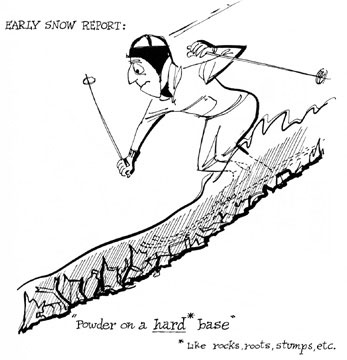The 1950s: Returning to the Rapid Growth Mode
Authored by Morten Lund
In the 1950s, returning GIs and homefront civilians were engaged in the delightful process of making up for skiing missed during the war. Many had saved quite a bit or made quite a bit during the war and could afford ski vacations. Some went for immediately enjoying life (no serious striving), a tendency illustrated in the cartoon on the March 1952 cover of Ski. The more serious skiers were now willing to pay for a course of instruction. Ski school became a normal entry to the sport, rather than the mirage of self-teaching. Most skiers actually learned to steer their skis so well that the classic hitting-the-tree cartoons stopped appearing, even though the sport took off in a minor boom, recruiting thousands of new skiers every year.
There was in postwar skiing, nevertheless a certain irreverence toward instructors fostered by ex-combat soldiers turned ski cartoonists. David Kemp, compiling music and lyrics in his 1950 Skiers’ Songbook in large part from ex-10th Mountain troopers, ran a cartoon showing a noncom turned instructor dispatching his class, with the usual military insanity, toward their doom. And former 10th Mountain cartoonist Snuffy O’Neil drew a strip called Christie targeting instructor goof-offs for the December 1952 issue of Skiing (then being published as The National Newspaper of Skiing).
A real change came about when wartime technology began to blow some goodies into the sport. Aluminum airframe engineers produced the aluminum Alu 60 and the Head. Mitch Cubberly produced the first cableless heel-and-toe release in 1951, and later the first modern step-in, one with a movable antifriction pad.
There was still a way to go as was well illustrated by Bob Cram in making his auspicious debut in American cartoon books by illuminating the problems facing the rank-and-file skier in The Jolly Skiers, published in 1952. He drew two deathless cartoons on the joys of the rope tow—wet, it delivered a shower bath; dry, it delivered smoke as the heat of friction fried the mittens.
But the days of the rope were numbered. The 1950s saw a massive infusion of production-line lifts into the country’s ski areas: chairs, T-bars—and Pomas, which came from France in 1951—signalled the nationwide shift from difficult hang-on-for-life ropes to the overhead cables offering all kinds of comfortable appurtenances to hang onto, or sit into.
Oh, yes. Ski conditions. Begin with the ice. It was often of mirror quality, as Cram points out. And awful snow underfoot was often aggravated by the perfidy of snow reports glossing over the hard truth. Snow reports themselves were a major hazard. Again, the white knight of technology got into the saddle. Steve Bradley was inventing the first grooming machine at Winter Park—the Bradley Packer, aka The Purple People Eater, a mogul-cutting snow groomer pulled by a foolhardy mountain crewman who risked being devoured by the spinning rotor of his machine. Grooming was soon transferred to a line of tracked vehicles called snocats and descended from the mountain troops’ prototypical over-the-snow vehicle, the Studebaker Weasel. In time, snow grooming would create the now-familiar, silky world of subdued surfaces that would make the iron-sheathed trail a thing of the past.
In Connecticut, a trio of engineers—Art Hunt, Milton Pierce and Dave Richey—working together as TEY Manufacturing, field-tested the first snowmaking device at Walt Schoenknecht’s Mohawk Mountain in Cornwall during the winter of 1949-50. The very first trial worked except for a supersonic whistle that set every dog in the county howling. Never mind. Within the decade, snowmaking would start to transform the stiffest underfoot stuff into malleable matter, thereby transforming the sport.
Then came the second postwar Winter Games, the 1952 Olympics at Oslo to set the general media on fire, not least because of the handsome Norwegian gold medalist Stein Eriksen with Hollywood good looks. The American public was galvanized as Andrea Mead Lawrence came within a hair of the hat trick in the alpine events, with two golds. Among the men, Bill Beck and Brookie Dodge took a fifth and a sixth. The fact that Americans could compete on a level with European racers precipitated a run on racing gear by ordinary skiers.
Yet novice racing had its downsides. Few ski schools had racing classes. Skill lagged behind desire. The gates themselves, made of splintery bamboo, were a hazard of the course. The risks of racing came under comic scrutiny by Bill Menzel in his 1954 sketch of a racer at the start and 1955 sketch of an impaled competitor, both appearing in Ski. Metzel. The two cartoons make a point. In the still-crude snow grooming at mid-decade, racing was not a piece of cake. Nor was skiing. Not yet.
The emergence of another notable American ski cartoonist of the century was evinced by the November 1959 cover of Ski, featuring Bob Bugg’s evocation of time’s passage. Even in America, the sport was old enough to begin taking a look back at the drastic developments characterizing the history of skiing. -- Morten Lund
